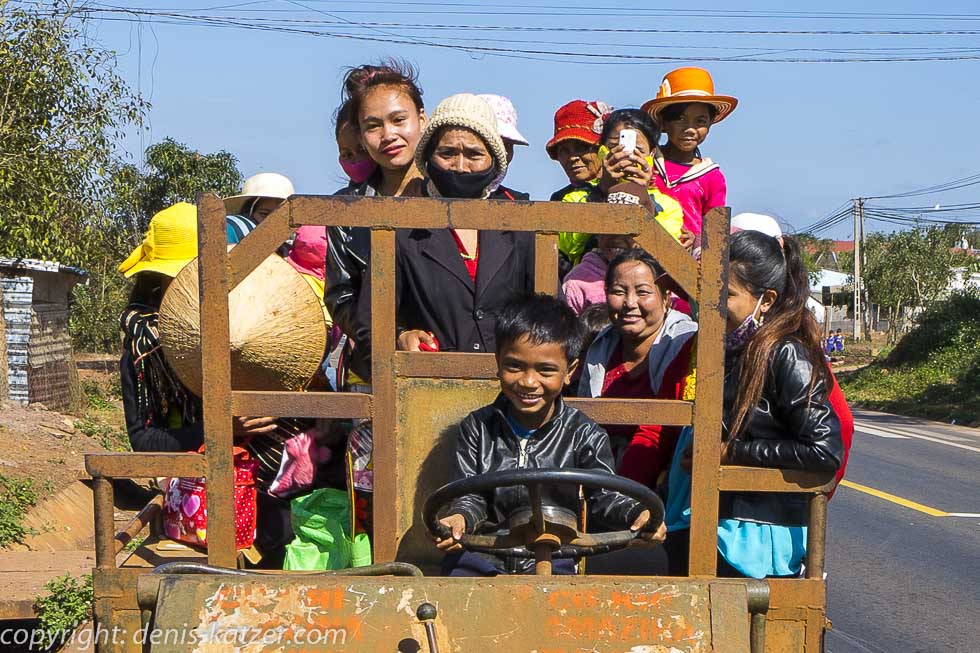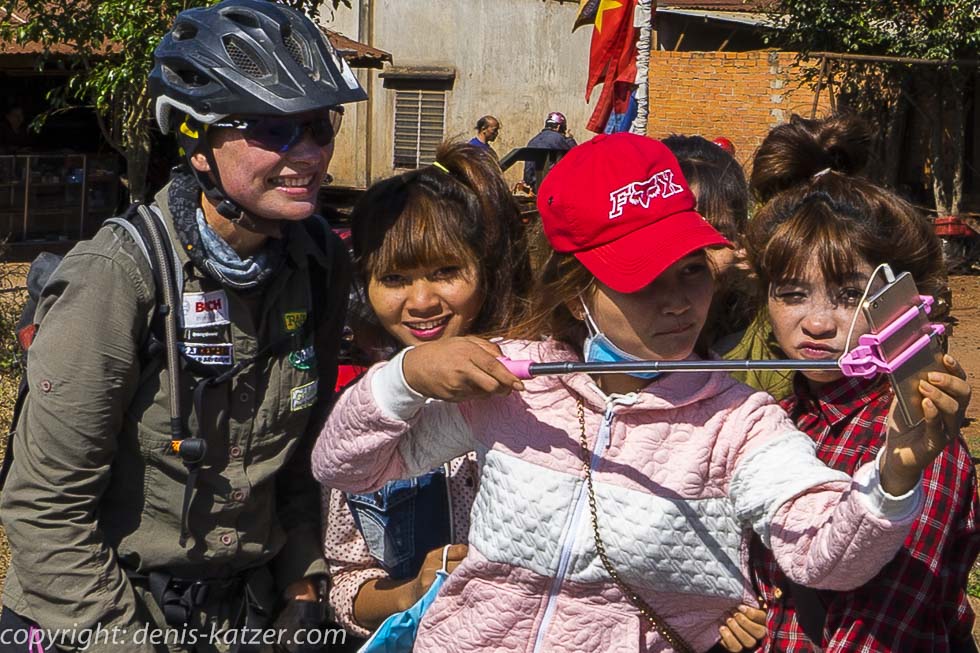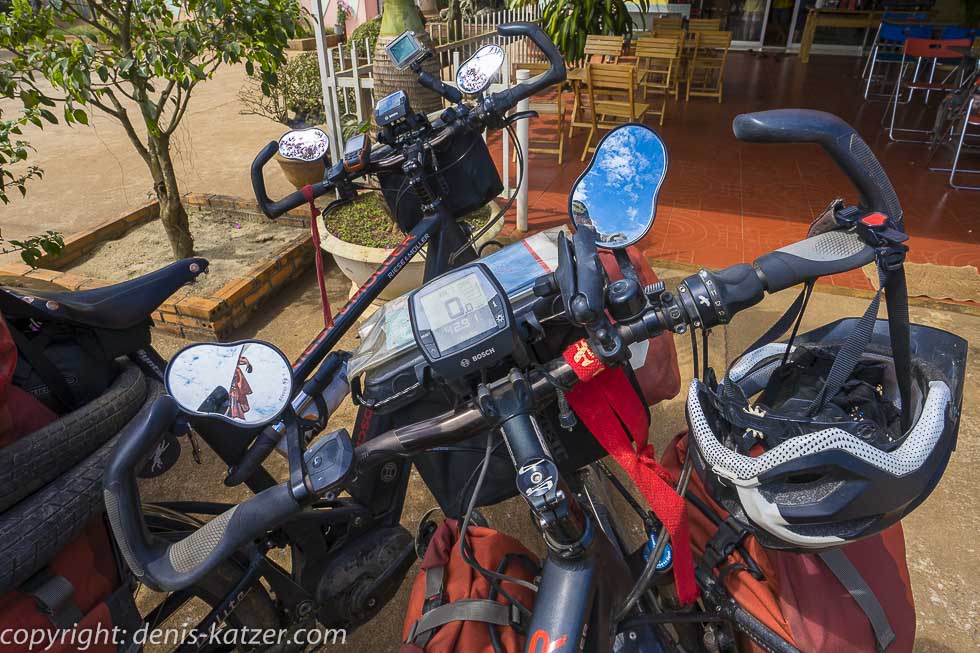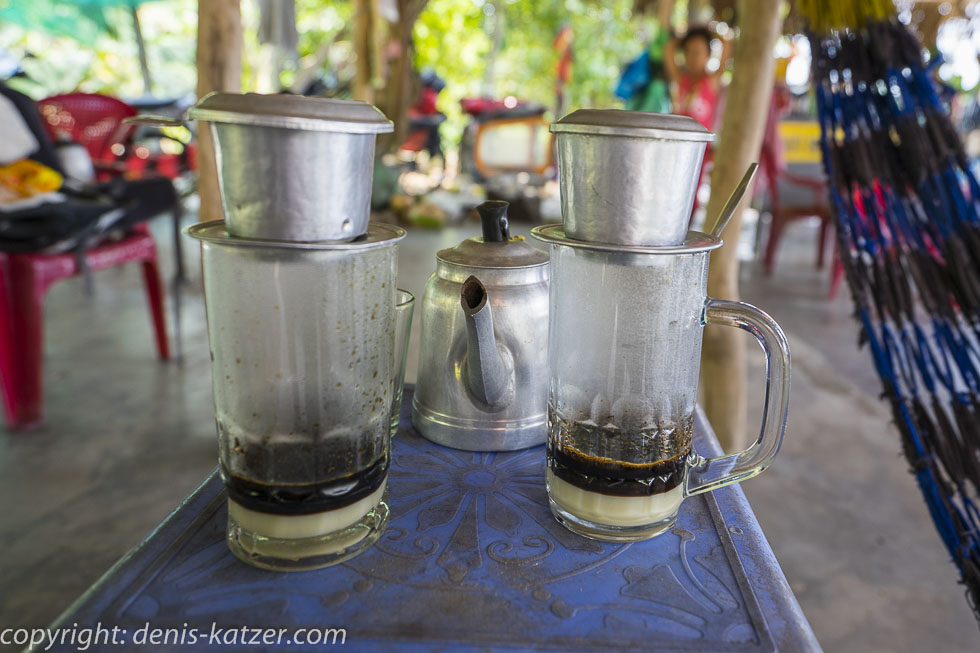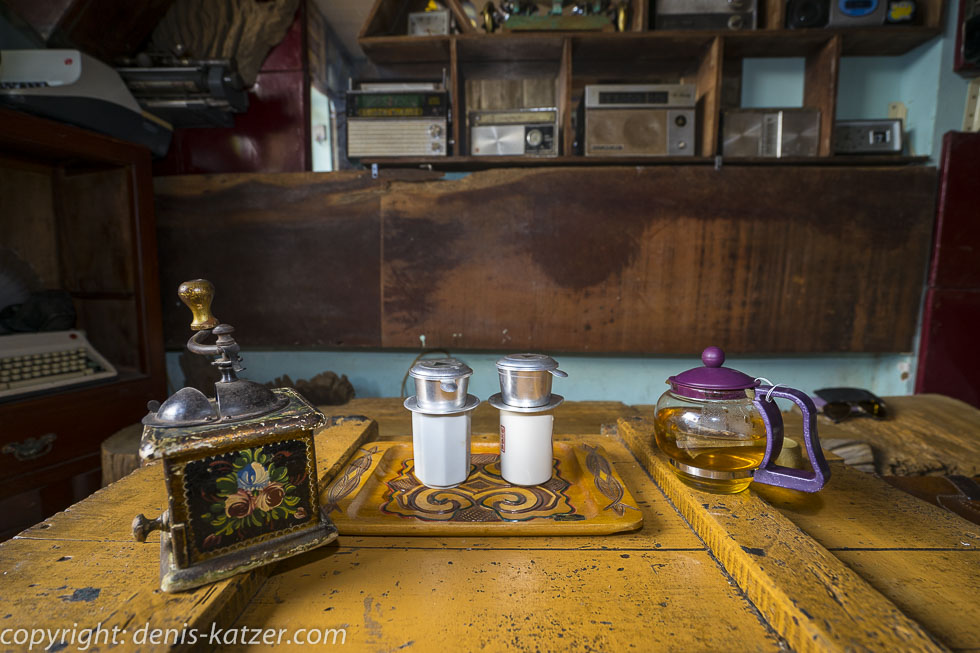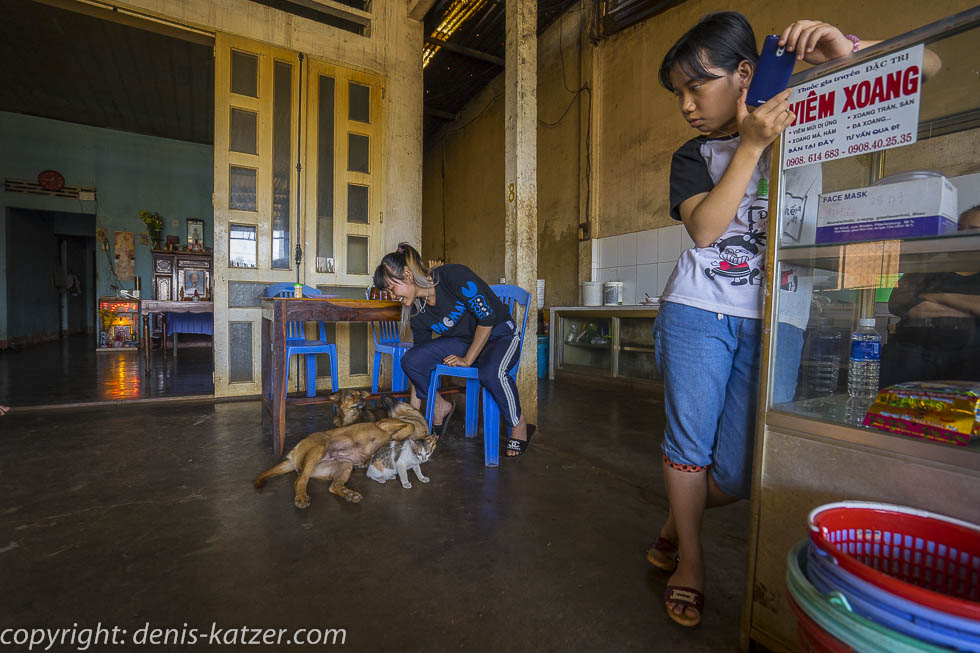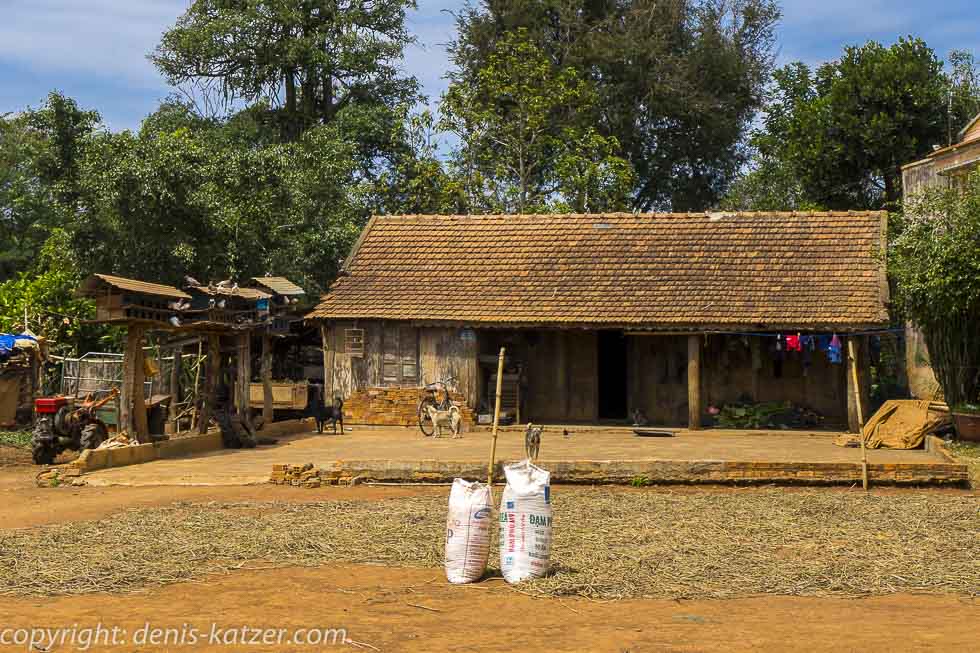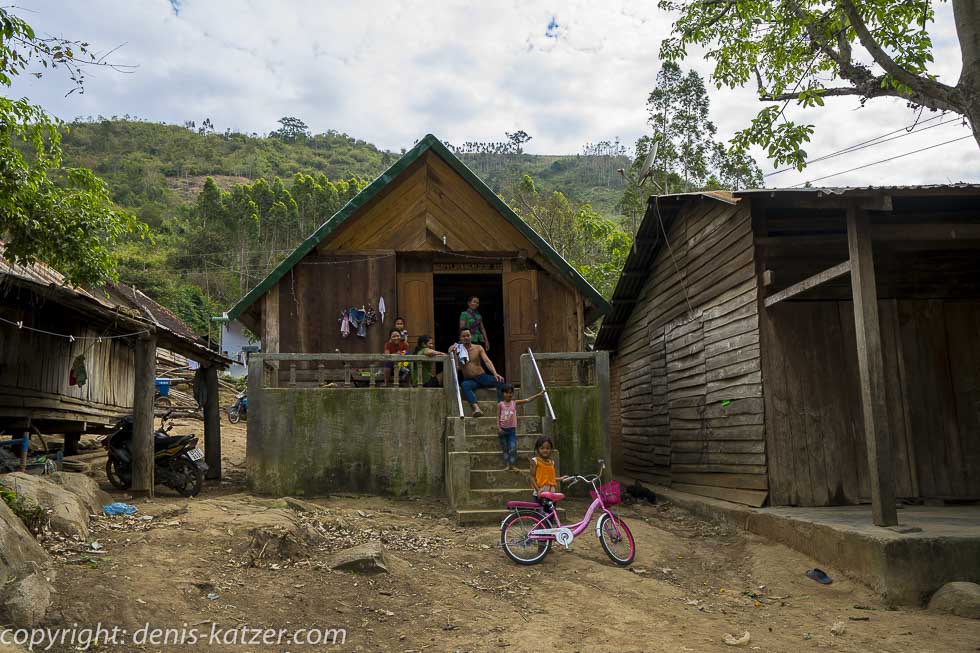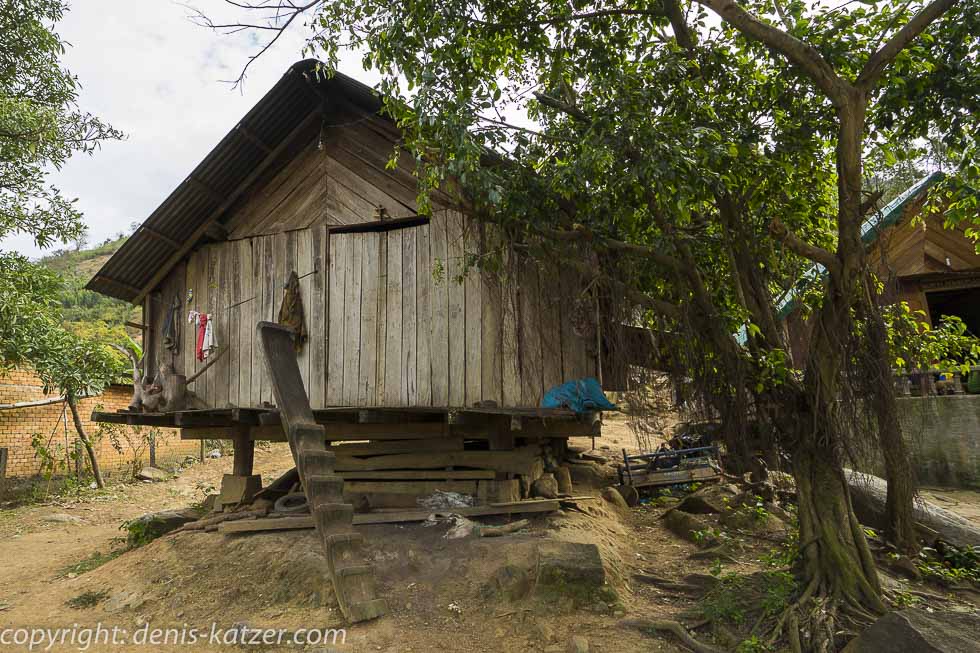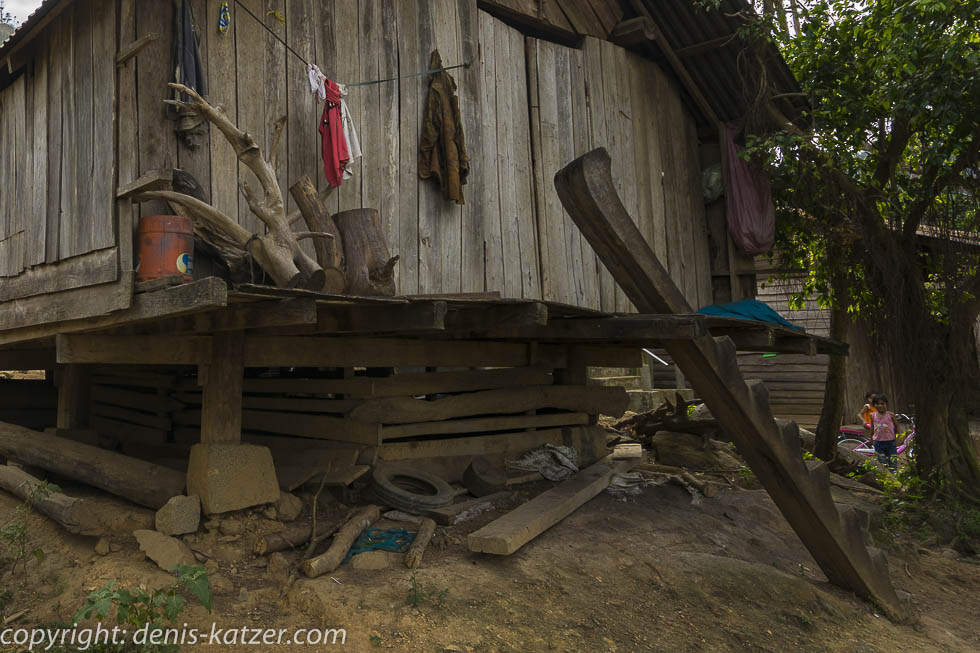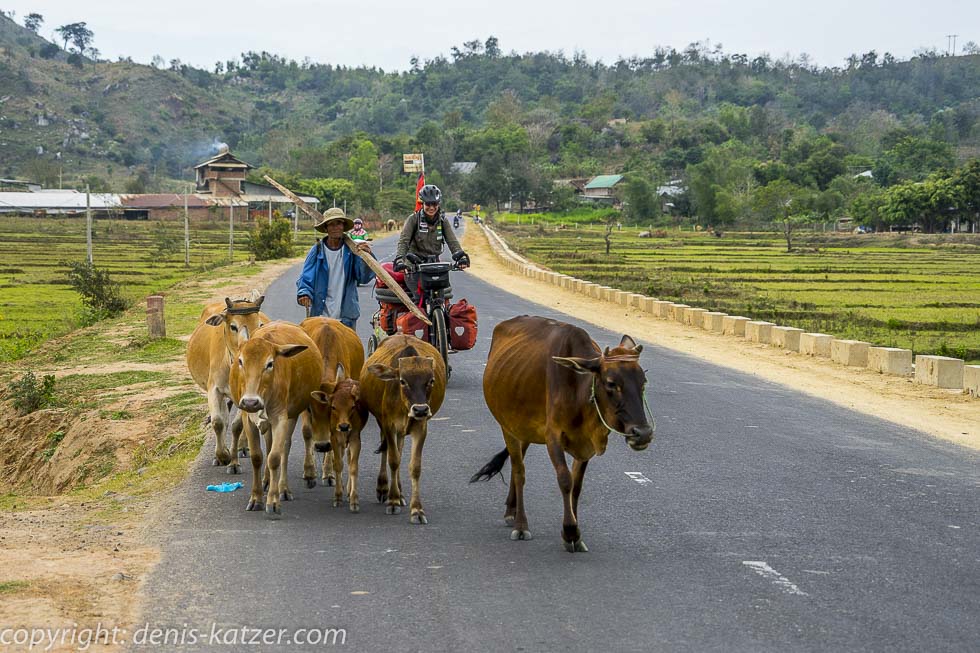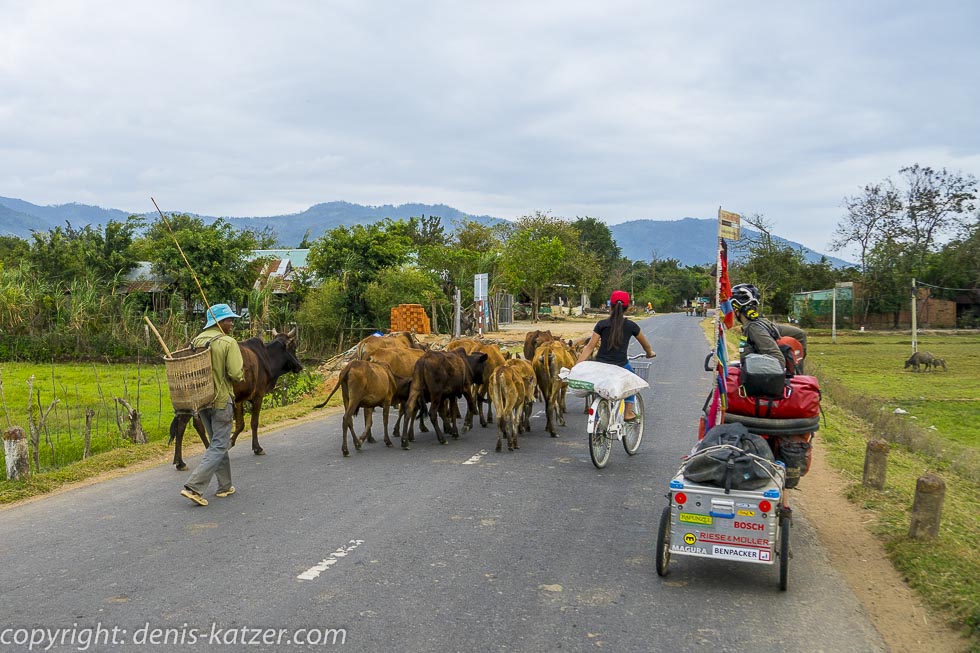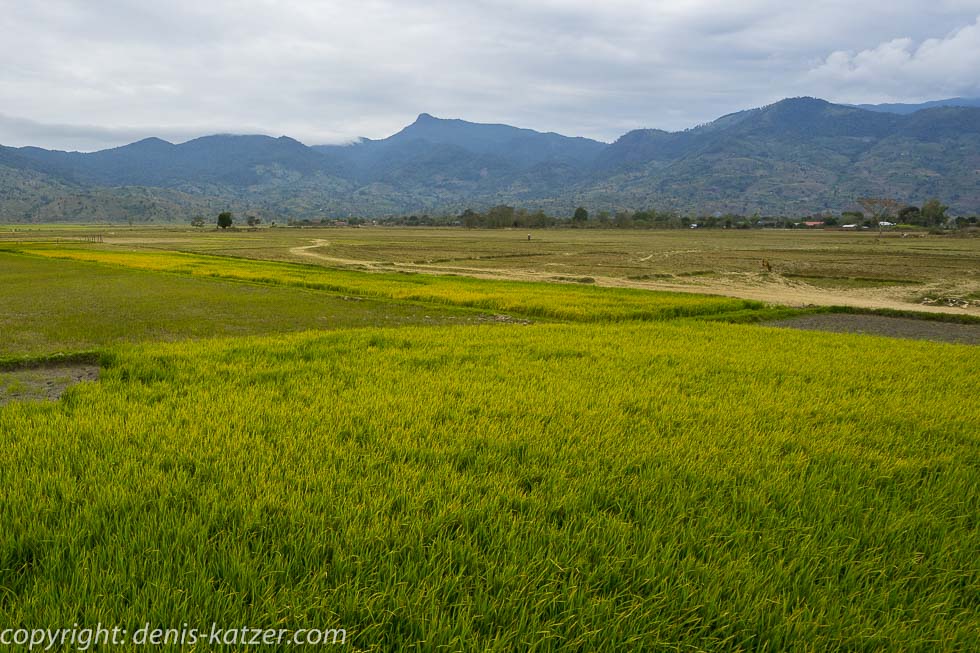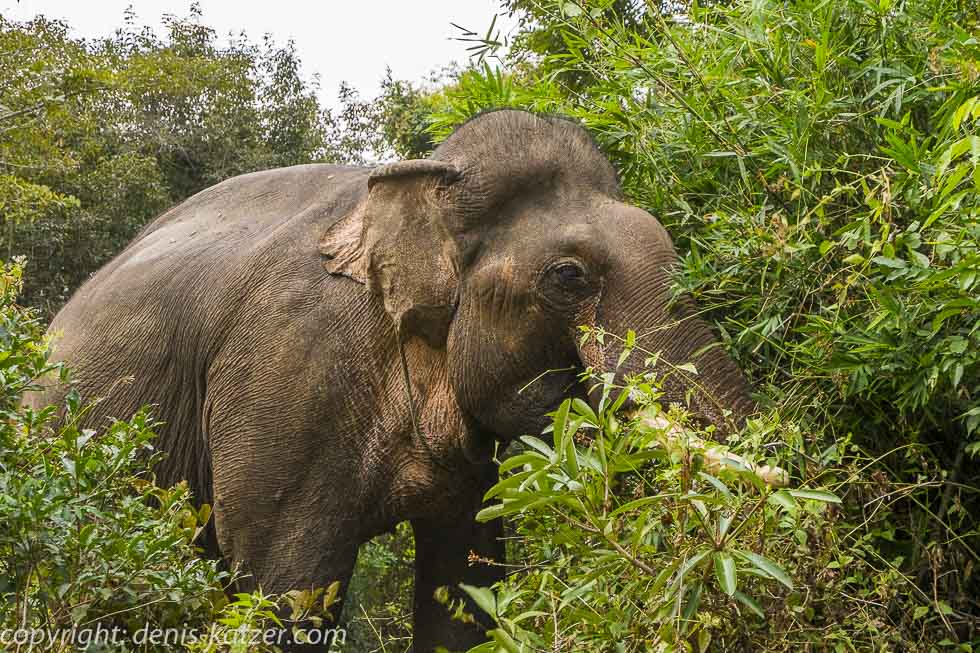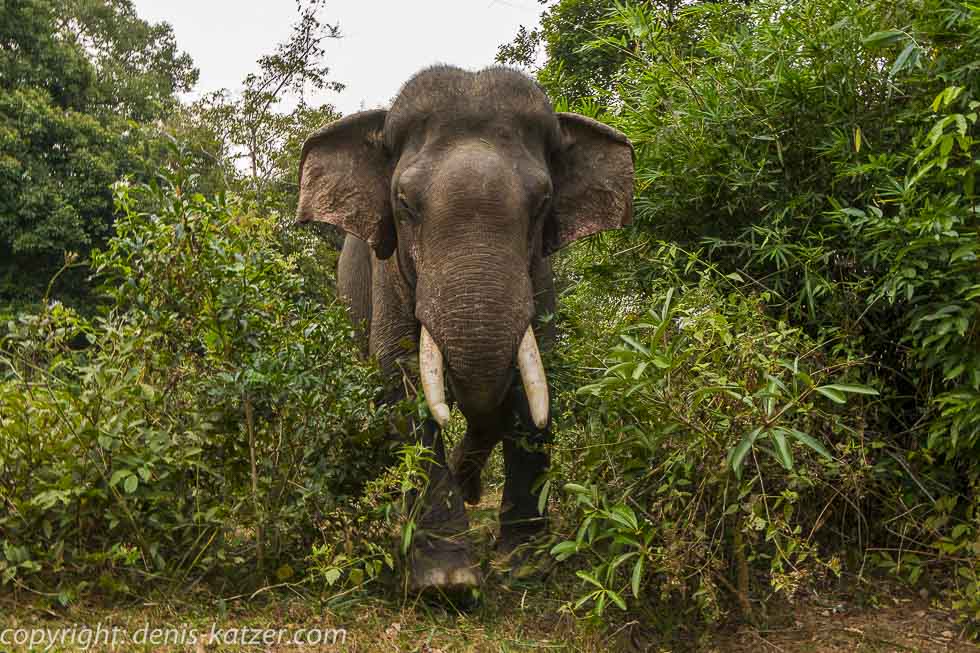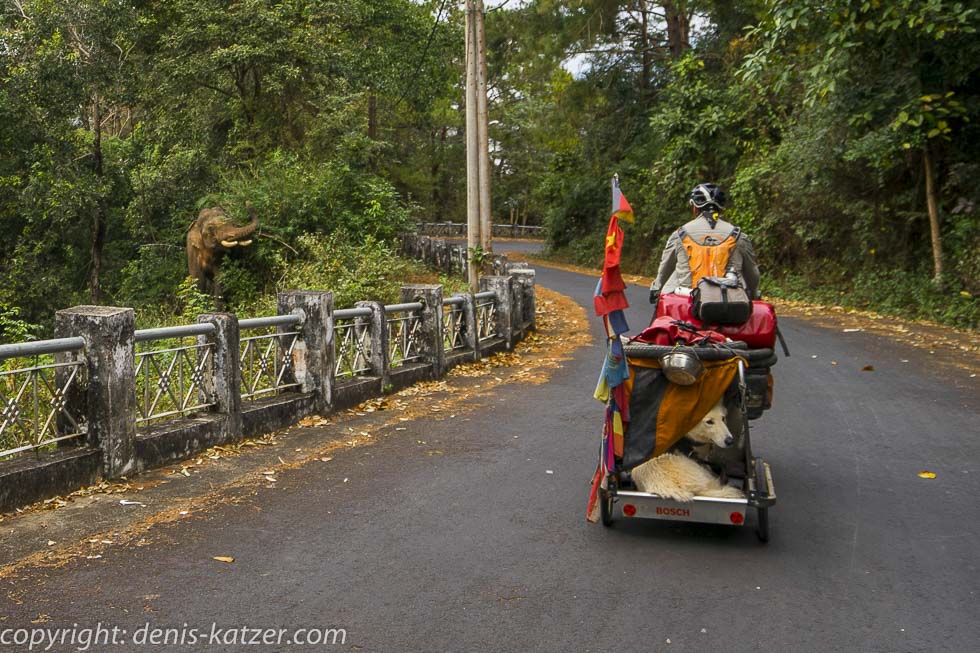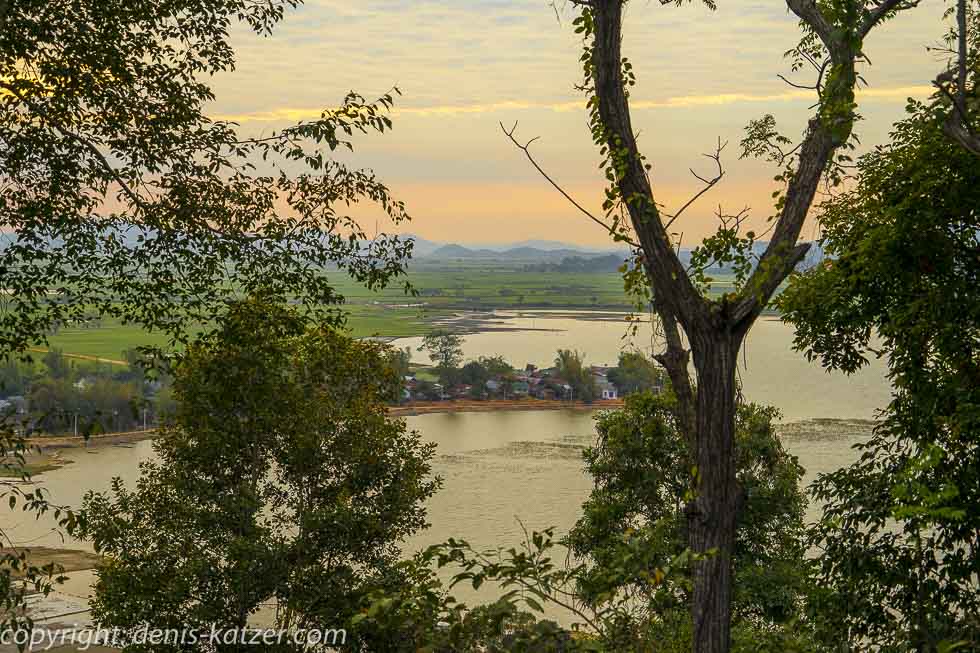
Attacked by an elephant – The horror has a name
N 12°24'43.9'' E 108°10'59.1''
Date:
19.02.2017
Day: 600
Country:
Vietnam
Province:
Đắk Lắk
Location:
Lien Son
Latitude N:
12°24’43.9”
Longitude E:
108°10’59.1”
Daily kilometers:
140 km
Total kilometers:
22,308 km
As the crow flies:
51 km
Average speed:
22.7 km/h
Maximum speed:
53.3 km/h
Travel time:
6:02 hrs.
Soil condition:
Asphalt
Maximum height:
900 m
Total altitude meters:
65.000 m
Altitude meters for the day:
1158 m
Headwind Wind force: 6
40 km/h
Sunrise:
06:07 am
Sunset:
5:54 pm
Temperature day max:
28°C
(Photos of the diary entry can be found at the end of the text).
Because we had a 105 km day yesterday and we didn’t want to overtax our bodies, we decided to cover only 40 km to the next location today. Tanja therefore carries our equipment from the second floor to the first floor without haste, while I get our trestles ready to go. Although the hotel where we spent the night is still under construction, it was a good stay. The owners are extremely friendly, our room was basic but clean, no mold, no old bedding and most importantly no karaoke bar in the house. Perhaps one reason for the restful sleep, because despite yesterday’s exhausting day, we feel quite fit.
We find a motel as early as 10:00 am. It makes a good impression. We stand in front of it and discuss whether we should check in. “It’s only 10:00,” I say, glancing at my arm computer. “Have we got our 40 km yet?” Tanja wants to know. “The speedometer shows 42 km.” “It went really fast today.” “Yes, regardless of our dawdling, we were already in the saddle at 8 a.m. this morning,” I reply and think about whether it makes sense to end the cycling day now. “How do you feel?” asks Tanja. “Top fit and you?” “Also.” “Shall we continue?” “An extra 40 km won’t do us any harm,” says Tanja cheerfully, which is why we start pedaling again, supported by our electric motors, at 25 km/h.
Just 10 km down the road, a colorful advertising sign promises freshly ground Vietnamese coffee. As we had planned a relaxed day today and had already covered 50 km by 10:30 a.m., we put our bikes in the shade of two small palm trees and order fresh coffee. It tastes so good that we immediately enjoy a second cup. “I never thought I’d get such fantastic coffee here in Vietnam,” Tanja chats, sipping her cup with relish. “Yes, you actually associate Asia more with tea. I didn’t know until a few months ago that Vietnam has been the second largest exporter of green coffee after Brazil since 2012,” I reply, taking another sip. “Do you know how coffee came to Vietnam?” “Yes, a Frenchman proudly told me recently.” “Why was he proud of it?” “Because coffee was introduced to Vietnam by the French colonial rulers back in 1857. Here in the central highlands, there are various climatic regions that are fantastic for growing different types of coffee. As you have seen, there are endless coffee plantations to the left and right of the road. So we’re right in the middle of the growing area,” I say. “When you go out for coffee in Germany, it sometimes tastes sour. Here it’s usually very good. I wonder why that is?” asks Tanja. “Hm, maybe the variety? The Robusta, Arabica, Chari, Liberica, Catimor and others that thrive here are processed into a unique blend. In Germany, the coffee consists almost exclusively of 100% Ararabica beans. This is, of course, a significant difference and therefore tastes great. But perhaps it is also due to the roasting. I have read that the beans are roasted slowly and vigorously, but do not burn and therefore retain their aroma. Some roasters even add liquid, clarified butter or cooking oils, while others add vanilla and sugar. Over the last 160 years, they have come up with quite a few ideas for the roasting process. The café owner here has freshly ground our coffee. The strong aroma has permeated the whole room like a wonderful cloud of fragrance.” “That’s right, it almost smelled a bit like smoky leather, spices and caramel,” Tanja agrees. “A great description of the smell.” “But I don’t quite understand why you put this sweet, thick condensed milk in your coffee. It loses a bit of the flavor.” “Oh really. It makes the black brew taste really good. It’s also a French invention, by the way. During the colonial era, cow’s milk was unknown in Vietnam. However, the French mothers living here wanted to feed their children with milk just like at home. As a result, they became inventive and boiled down and preserved milk. Adding sugar made the milk even more durable. They sealed it in cans and were thus able to ship the condensed milk on the long sea voyage to Indochina. I think it didn’t take long for the glorious idea of adding sweet soured milk to coffee to come about. Only then did the really genuine, traditional Vietnamese coffee come into being.” “And if you add your ice cream, you have a refreshing iced coffee,” says Tanja. “Exactly. It’s great when we don’t have to cycle such long distances. Then we’ll even have time to philosophize about Vietnamese coffee. I could go on like this for the next 5,000 km,” I say, sipping my cup.
As we continue our journey, we pass many churches and beautiful Buddhist temples. We take a short break at particularly beautiful buildings to take a look inside. Shortly before 12:00 we stop at one of the many soup stalls. The owners are all excited about Ajaci and chatter away without a dot or a comma. Everyone wants a selfie with the big white wolf, so the cook forgets to make us a phở (soup).
14:00. Although we only wanted to cover 40 km and the number 80 is already on the speedometer, we are still full of energy. “Well, I’m still fit. How are you?” I ask Tanja. “Great” “Okay, then we have to make a decision at this fork in the road. If we want accommodation for the night, we’ll have to turn right to reach the capital of Dalat province. There in Buôn Ma Thuột, we’re sure to find some accommodation that will take us, even with a dog. The disadvantage, however, would be that we would have to return to this fork in the road tomorrow, because if we turn left here, we will reach the national park where there are elephants,” I think aloud. “How many kilometers to the national park?” “About 50 km, but maybe 60 km. Depending on where we find somewhere to spend the night.” “Phew, that would be 130 to 140 kilometers per day?” “If nothing comes up, we’ll make it before dark.” “How’s your knee?” “It’s fine.” “We still shouldn’t overdo it. 140 km is a hell of a lot. But I don’t fancy the detour tomorrow morning either.” “Yeah, and cycling into a big city today isn’t much fun either,” I say. “So, what do we do?” asks Tanja. “I’m in favor of riding on.” “Let’s go!” shouts Tanja, and we pedal hard to turn a planned short day into a really big day.
At 3 p.m., a strong wind with a force six (approx. 40 km/h) blows towards us. “But that wasn’t planned!” exclaims Tanja. “Certainly not,” I reply, doubting whether we have really made a wise decision. Our speedometers show 100 kilometers per day. After another turn-off, we reach a narrow road with very little traffic. The wooden huts on the roadside are built in the traditional style. Some of the steps to the house consist of a single tree trunk into which deep notches have been cut. The farmers who live here are visibly poor people who for the most part have to get by without any luxury. Their openness and friendliness is astounding. Even though it’s almost normal in Vietnam, it’s not just the children who wave to us here, but soon every adult. The familiar, “Hello! Hello! Hello!”
We cross a wide, beautiful valley, which is bordered on all sides by mountains. “If we still have to cross it today, then cheers!” Tanja shouts. Farmers herd their cows on the road. Although I’m now dog-tired again, I get off my bike to photograph some of them. They stop and look friendly into the lens. “Tạm biệt” (goodbye), I say goodbye and earn an endearing smile.
At 17:00, with a speedometer reading of 130 kilometers, we reach our destination, Lak Ho. (Lak Lake). The low sun casts its warm light onto the smooth surface of the water. “Wow, it’s beautiful here,” I shout to Tanja as we cycle along the shore. “Those huts back there look like they belong to a resort. Let’s go there,” I suggest. “This is definitely not the guest house I found on TripAdvisor.” “It doesn’t matter. It’s only a maximum of one kilometer to the huts. If that’s nothing, we can always drive to the guesthouse,” I suggest. Once there, we park our bikes and almost stumble off our bikes from tiredness. “Lak Resort”, Tanja reads the lettering on a dilapidated concrete bench standing in the dark shade of a tropical tree. “Man, I can’t believe it. This is the resort that some travelers have warned about on TripAdvisor. One wrote as a headline: The horror has a name – Lak Resort,” says Tanja. “Hm, the grounds look really run-down,” I realize and let my gaze glide over the jungle-like garden with its partly broken paths. “I’ll go to reception and ask if they have a room available. Just to be on the safe side in case the other place is fully booked,” I say, because, like Tanja, I don’t feel like staying here for just one night. “Hello, hello, is anyone there?” I call out and listen to the silence. “No one there,” I say to Tanja later. “Well, that suits the view here,” she says. Undaunted, we get back into our saddles and ride back to where we were a quarter of an hour ago. “That’s the way to Bao Dai Villa,” I shout as we drive past a sign pointing up a hill. “Ten horses won’t get me up there today,” Tanja is certain.
We pedal our horses through the village of Lien Son, not far from the lake, crossing a small market that barely allows us through because of its hustle and bustle. By now our nerves are on edge. Maybe it was a bad decision to have chosen this long route after all. I steer my heavy bike past the stalls just a few centimeters away. Chickens cluck excitedly in their wire cages. Ducklings, crammed together in a flat wire mesh, chatter loudly. Small mopeds, on whose narrow seats sometimes up to two adults and three children squeeze together, zigzag alarmingly close to our luggage. The passageway we are on is a maximum of 1 ½ meters narrow. Time and again, cyclists and moped riders simply stop in the middle of the road, triggering a concert of horns and bells from the others. A basket of potatoes falls over right in front of me. The brown tubers roll across the path. A moped rider doesn’t care and rattles over it. The farmer’s wife curses and swears loudly. We wait until she has collected her precious goods and continue to push our bikes through a chaos that is difficult to describe in words. Finally we are through and ask for the Van Long Lak Lake Guesthouse. Children surround us. They shriek and scream excitedly when they discover Ajaci in his trailer. One of them picks up a stone and wants to throw it at Ajaci. “Nooo!” yells Tanja. The boy drops the stone and runs away. We reach the guest house and park our bikes. None of the employees pay any attention to us. “What’s going on here?” asks Tanja. “They seem to have too many tourists,” I reply and look for the reception desk. A young Vietnamese woman asks me to follow her, scowling. She shows me a traditional longhouse which is used as a dormitory. “We have a dog with us. We can’t sleep in mass accommodation. Don’t you have any rooms available?” “No. We’re fully booked today and for the next few days,” I hear the devastating answer. On the way back to Tanja’s I pass a cage in which a huge python is just rising from the wire mesh. “Wow!” I shout in shock and jump a little to the side. “That’s a colossus,” I say to the girl, pointing at the snake, whose body has a diameter of at least 20 centimetres without exaggeration.
“Fully booked,” I say to Tanja when we get back to the bikes. We stand around for a few minutes, somewhat indecisive. We ask a tour guide if he knows of any other accommodation here. “There’s not much. Maybe try Lien Son, directly opposite the post office, or the Lak Lake Resort,” he suggests. We say thank you, get on our bikes and ride back to the center of Lien Son. We walk through the small, hectic market again. Because we can’t find the hotel, we end up back at the lake. “Let’s drive up to Bao Dai Villa. There are rooms there too,” I guess. Tanja accepts it without comment. The narrow, asphalted road winds steeply upwards through a deep green jungle. We only manage to pedal up our bikes in first or second gear. Something rustles in the bushes in front of us. It must be something bigger, because a huge bush is moving massively. “An elephant!” I am amazed. We put the bikes on the stands. To prevent my bike from rolling backwards down the incline, I pull the trailer brake, as I often do on such slopes. We stand there in amazement and watch the bull elephant eat. The only thing separating us is a 30-centimeter low road boundary and a small 10-meter area overgrown with bushes. “Unbelievable,” Tanja marvels. Without being disturbed by us, the giant calmly continues to munch on the large bamboo bush. I take a few pictures. “Do you have the bikes in the foreground?” asks Tanja. Sure, otherwise nobody would believe us,” I reply. I move closer so that I no longer have the distracting road boundary in the picture. I press the shutter release again. Suddenly the bull elephant stops munching and looks at me. Years ago we spent many weeks traveling with an elephant in the lowlands of Nepal, so I know a little about the facial expressions and gestures of an elephant. I’m just about to take a few steps backwards when the bull suddenly attacks. Around 3,500 kilograms of muscle mass rush towards me. “Aaahhhh!” I scream in terror and try to escape in a panic. The bull elephant stops abruptly at the small barrier and hurls his long, muscular trunk at me. Sssshhhh! The thin end of a bamboo stick, which he holds in the gripping finger of his trunk, slams just a centimeter past my face. The green stuff hits the sunshield of my helmet, causing my bike helmet to slip down my neck. “He’s tied up,” Tanja notes. “Phew, thank goodness,” I snort, realizing that I owe my life to this circumstance. “He even tried to catch me with the bamboo,” I say, pointing at the thing in front of me. “Unbelievable.” “Absolutely. I almost wet my pants,” I stammer a little meekly. “No wonder,” says Tanja. Before I put the camera away again, I take a look at the last picture. “I’ve got it.” “What have you got?” “When the elephant attacked, I was terrified and pressed the shutter release, and guess what, the picture turned out. Great,” I say happily, although I know that this action could easily have backfired. It is quite possible that the mahout (elephant handler) has not secured his animal for an attack, at least there is no tree to be seen in the immediate vicinity of the elephant to which an elephant could be chained. In other words, he probably just tied it to one of the bushes. Since elephants are able to move tons, it is not difficult for them to tear themselves away from a bush. So I was lucky this time, I think back to my accidental jump from the bamboo bridge a few months ago.
We leave the largest land mammal on earth and continue pedaling up the mountain. Once we reach the top, we are greeted by a house that has seen better days. The view over the lake from here is fantastic. The sun has sunk behind the distant mountain ridges in a dramatic play of colors. I go into the house in the dim light. “Helloooo!” I call out again. No answer. There are pictures on the wall documenting various hunting scenes. A European big game hunter sits on an elephant with a rifle. A worn, stuffed crocodile hangs on the wall. “Yes,” a woman’s voice startles me. “Man, they really gave me a fright.” The Asian woman replies with a smile. “Do they still have rooms available?” I ask, my heart still pounding. “We have. Would you like to see one?” she asks in English. Before I go to the trouble of looking at one of the rooms in the mold-smelling villa, I ask if there is anything for us to eat up here. “If you want to eat, you have to drive down to the city. We don’t have a kitchen at the moment. Breakfast is also available down at the Lak Lake Resort,” she explains. I learn that the Bao Dai Villa was once the hunting lodge of an emperor. So that’s the reason for the pictures and trophies. “I don’t want to stay here,” says Tanja. “Okay, then we have no choice but to drive back down. There’s supposed to be a higher-quality resort there. Maybe we can negotiate a good price for ourselves there,” I think. As we cycle past the aggressive elephant again on the descent, Tanja takes another picture from a safe distance: ‘Denis on e-bike past the elephant’. Because we can’t find the upmarket resort, we end up at the small market for the third time. This time we discover the city hotel in the center of Lien Son. We stand in front of the concrete bunker, undecided. “We’re not far from a national park and we’re sleeping in such an ugly house. Apart from the usual traffic noise, there’s no sign of nature here,” I realize, but I’m ready to check in immediately because I’m so tired. “In this case, I would prefer ‘Horror has a name’,” says Tanja.
It’s 6 p.m. and dark when we arrive at the horror store 10 hours after setting off today and having covered 140 kilometers. This time the reception desk is manned. We actually get one of the run-down bungalows for an exorbitant price of 750,000 dong (€31). I didn’t even question whether our Ajaci was allowed in here. Our bikes are accepted at the small reception. A plus point for this shed. The plaster in the room is peeling off the walls, all the sockets have a serious loose contact or don’t work at all, some cupboards have no doors, almost all the light bulbs have failed and have not been replaced, the doors to the bathroom and terrace are completely rusted, the decrepit fridge is noisy and there is an old tube TV on one of the worn low cupboards. “Pure nostalgia,” I say with a laugh. “It doesn’t matter, the main thing is that we have a bed to sleep in”. “Right, and tomorrow the world will certainly look better,” I mean…
If you would like to find out more about our adventures, you can find our books under this link.
The live coverage is supported by the companies Gesat GmbH: www.gesat.com and roda computer GmbH http://roda-computer.com/ The satellite telephone Explorer 300 from Gesat and the rugged notebook Pegasus RP9 from Roda are the pillars of the transmission. Pegasus RP9 from Roda are the pillars of the transmission.
